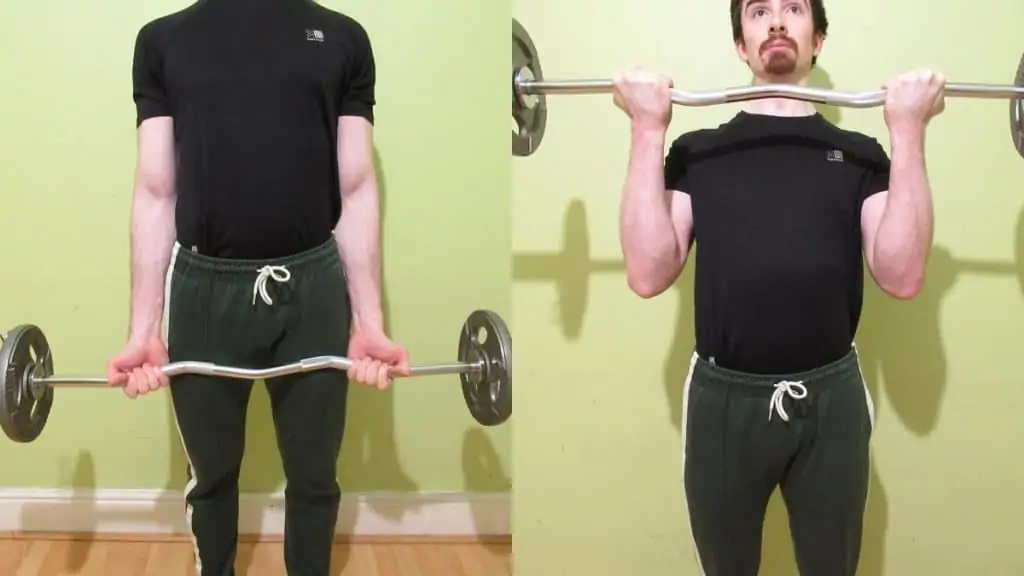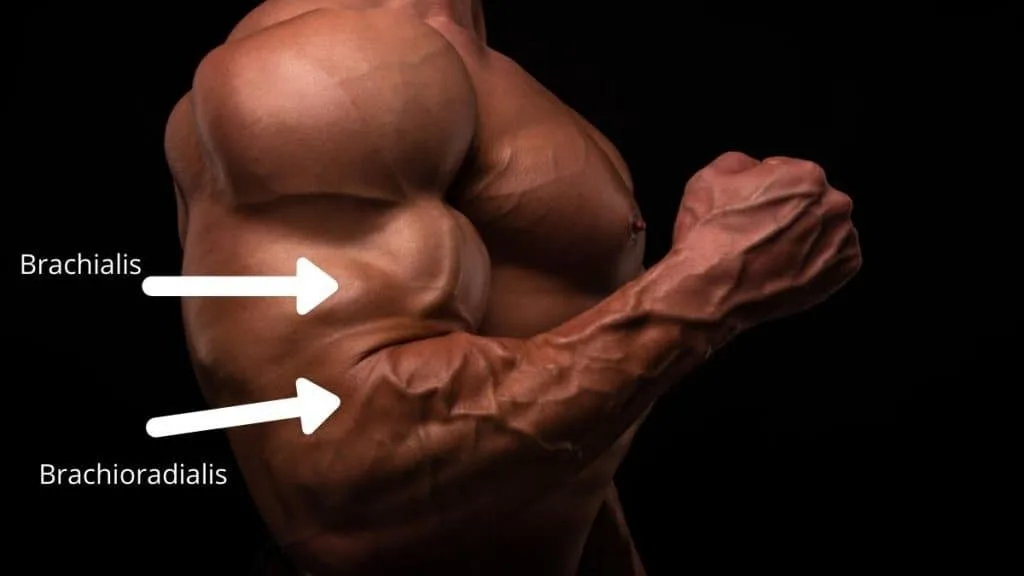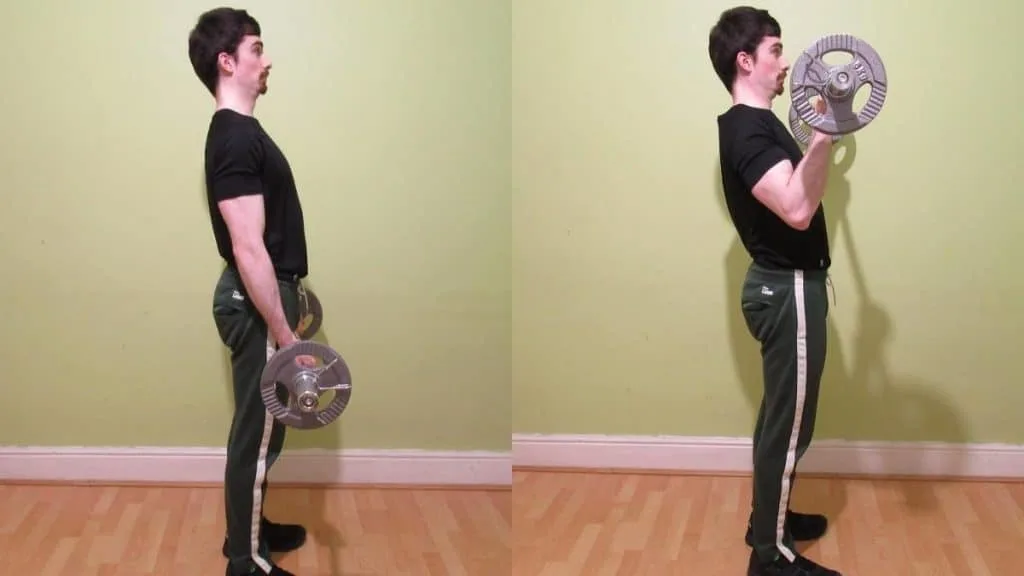The biceps function to flex the elbow and supinate the forearm. So any exercise that trains these two functions ticks all of the bicep-building boxes.
Cambered bar curls are one such exercise. They’re highly convenient to perform because all you need is a cambered bar and a few weights, which makes them ideal if you train at home.
Best of all, the standing cambered bar curl puts less pressure on your wrists than its barbell counterpart because the bar naturally places your wrists in a joint-friendly, semi-supinated position.
Cambered bar curl exercise details
- Also Known As: EZ barbell curl
- Main Muscles: Biceps brachii
- Secondary Muscles: Brachialis, brachioradialis, forearm flexors
- Exercise Type: Strength
- Exercise Mechanics: Isolation
- Difficulty Level: Beginner
- Equipment Needed: Cambered bar, weight plates
How to do cambered bar curls
- Load an appropriate amount of weight onto a cambered bar.
- Grab the bar with a shoulder-width underhand grip.
- Stand up straight and let the bar rest against your thighs.
- Curl the weight toward your shoulders while keeping your elbows still.
- Keeping lifting until the undersides of your forearms make firm contact with your biceps.
- Hold the contraction for a moment and then lower the weight under control until your elbows are completely extended.
- Repeat for 3-5 sets of 6-15 reps.
Benefits of cambered bar curls
The camber curl builds your biceps while providing enhanced protection for your wrists. But that’s not all you can expect to gain from doing this exercise consistently.
Reduced wrist strain

Cambered bar curls place your wrists in a semi-supinated position. This takes the strain off your wrists and forearms and ultimately helps you to avoid injuries.
So if the straight bar hurts your wrists, give the standing cambered bar curl a go instead.
You can even make cambered bar bicep curls your primary exercise if you like. After all, curling with semi-supinated palms is a much more natural hand position to take than a fully supinated one.
There’s a reason why we don’t walk around with our palms facing forward—it’s unnatural. Add heavy weights into the equation, and you have a recipe for wrist discomfort. That’s why cambered bicep curls are becoming more and more popular among weight lifters.
Better brachialis and brachioradialis development

Performing camber curls means using a semi-supinated grip, which, depending on your point of view, could be both a good thing or a bad thing.
Using a grip like this decreases bicep involvement slightly because your wrists aren’t maximally supinated. So if you want to focus purely on building your biceps, the camber curl is still good, but it’s not completely optimal.
On the other hand, doing curls with a cambered bar naturally shifts some of the tension onto your brachialis and brachioradialis muscles. These are two powerful elbow flexors [1] that most lifters overlook, and they can dramatically enhance the appearance of your arms when they’re well-developed.
Specifically, building your brachialis can help to make your biceps appear broader and more peaked.
Beefing up your brachioradialis, on the other hand, will make your lower arms look thicker and more imposing. In other words, your forearms won’t be dwarfed by your biceps if you have a strong brachioradialis.
Great for strength gains

Many lifters prefer using dumbbells to train their biceps. And while this training tool certainly has its place, the large weight increments make it hard to gain strength rapidly because they can often be 5lbs or more per side. That’s a lot of extra resistance for a relatively small muscle like the biceps.
With the standing cambered bar curl, however, you can gain strength quicker by increasing the resistance in more manageable increments. So over the long run using the bar will enable you to overload your biceps with heavier weights and stimulate more muscle growth. [2]
You can also use convenient and inexpensive microplates to make the weight jumps even more manageable. Sure, they might be a bit of a hassle to bring to the gym, but they can help you to smash through a cambered bar curl plateau if your strength is stagnating.
Variation: Cambered bar preacher curls

Cambered bar preacher curls are one of the most effective preacher curl exercises that you can do to build your biceps. By bracing your arms against the pad, you instantly increase your bicep stimulation by taking your other muscles more or less out of the equation.
Or, to say it another way, you can’t effectively swing the weight up with your back, legs, hips, or shoulders because all of these muscle groups are stabilized by the preacher bench.
To perform cambered bar preacher curls, load some weight onto the bar and place it in the rack.
Then follow these instructions.
- Hold the bar with a shoulder-width supinated grip.
- With your arms braced against the sloped side of the pad, curl the bar toward your front delts.
- Keep curling until your forearms forcefully press up against your biceps.
- Squeeze your biceps at the top of the rep.
- Lower the bar under control until your arms are fully locked out.
- Perform 3-5 sets of 6-12 reps in total.
Conclusion: How to get the most from your cambered bar curls

To maximize the effectiveness of your cambered bar curls, make sure to keep your elbows still while you lift the weight. It’s okay to allow a small amount of shoulder movement at the top of the rep to intensify the peak contraction, but all of the initial movement should come purely from your biceps.
The standing cambered bar curl works at any rep range. We recommend doing sets of 6-12 reps most of the time so that you can accumulate enough training volume to build muscle. Of course, you can also finish off your biceps after a heavy workout by doing high rep cambered bar curls as well.
References
- Pirie, E. (2021, February 23). Arm muscles. Kenhub. https://www.kenhub.com/en/library/anatomy/arm-muscles
- Goulet, C. (2020, October 23). The Progressive Overload Principle: Train For Continued Growth. Bodybuilding.Com. https://www.bodybuilding.com/content/progressive-overload-the-concept-you-must-know-to-grow.html

